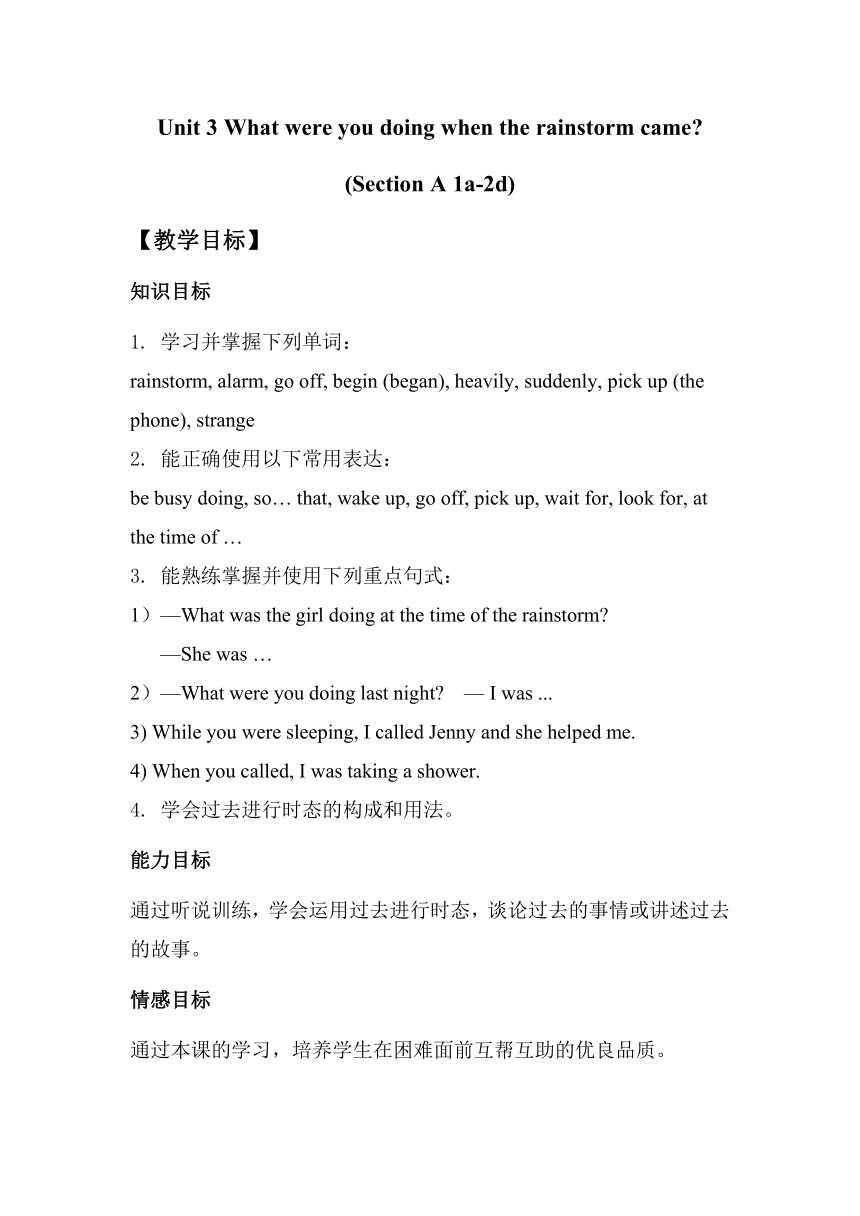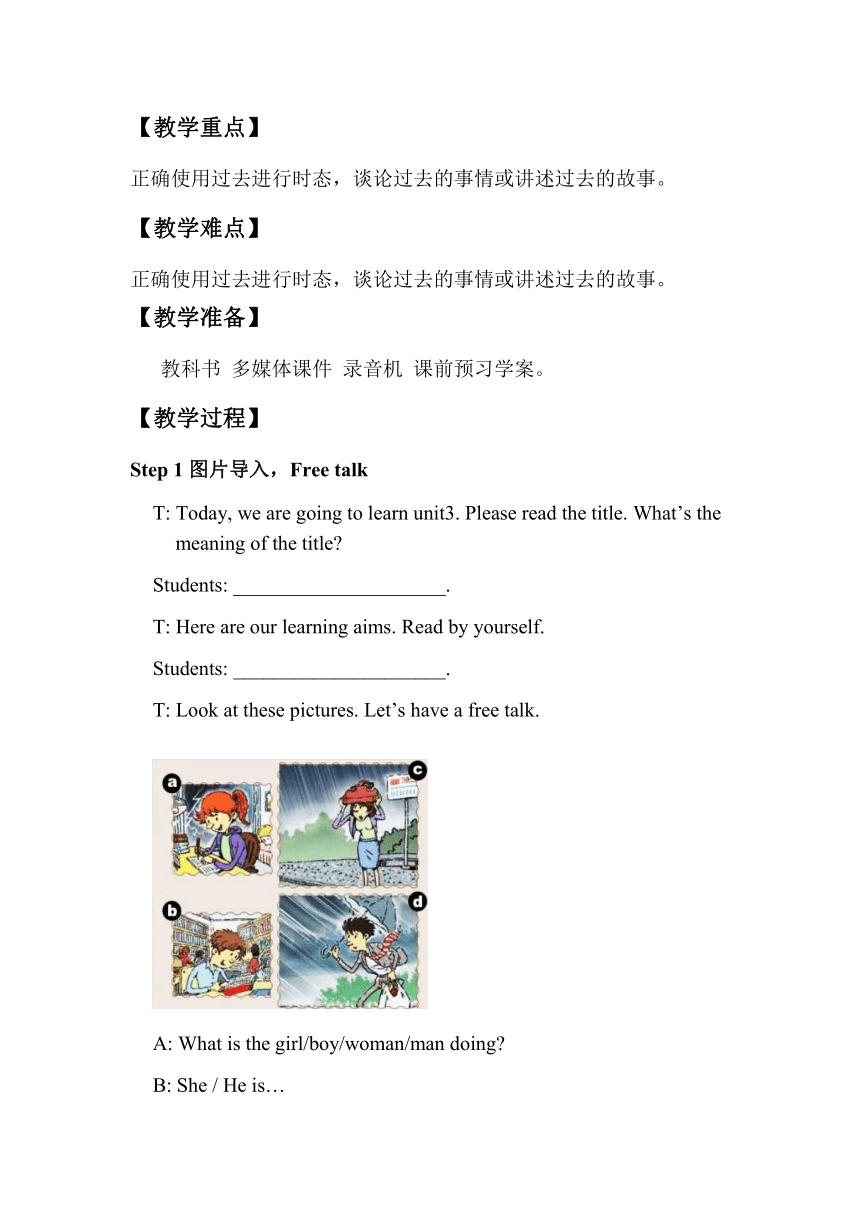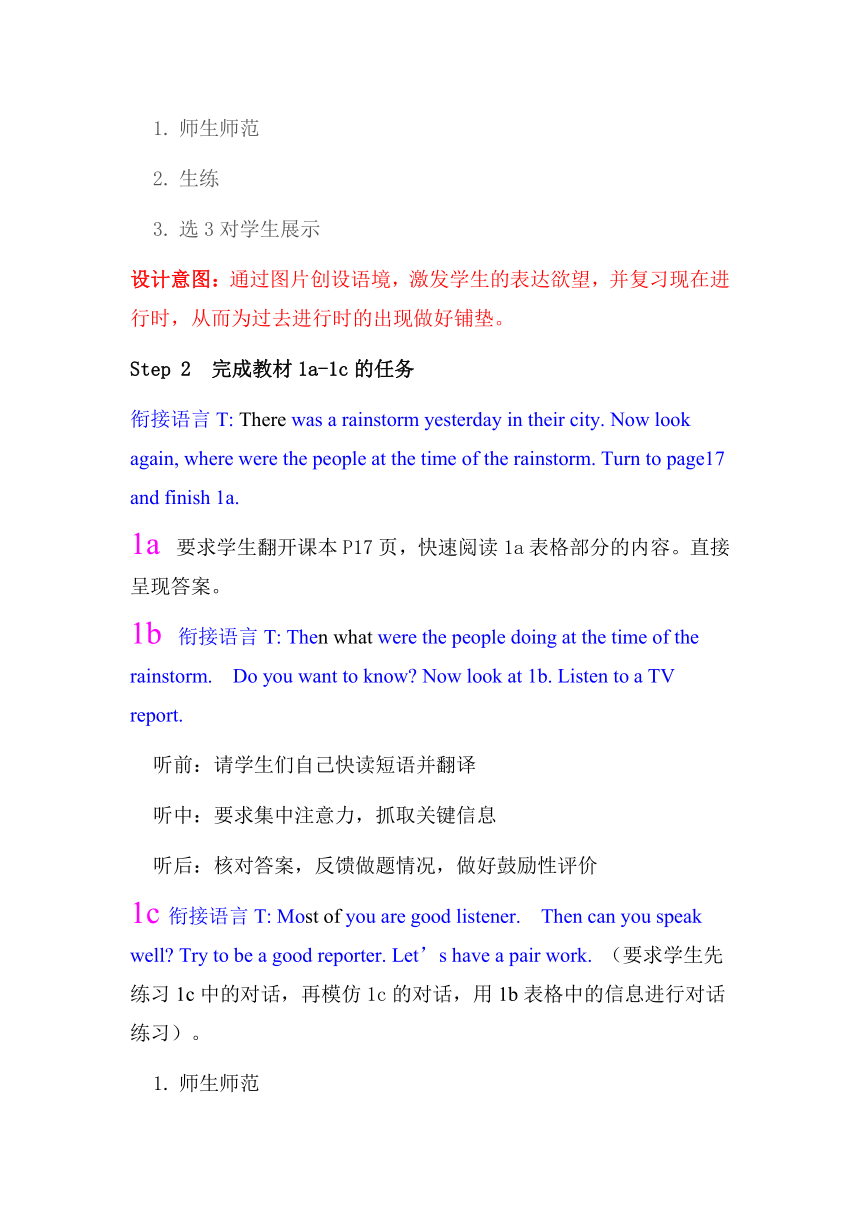鲁教版八年级英语上册Unit 3 What were you doing when the rainstorm came?Section A (1a-2d)优质教案
文档属性
| 名称 | 鲁教版八年级英语上册Unit 3 What were you doing when the rainstorm came?Section A (1a-2d)优质教案 |

|
|
| 格式 | zip | ||
| 文件大小 | 424.7KB | ||
| 资源类型 | 教案 | ||
| 版本资源 | 鲁教版 | ||
| 科目 | 英语 | ||
| 更新时间 | 2017-01-07 16:49:14 | ||
图片预览



文档简介
Unit
3
What
were
you
doing
when
the
rainstorm
came
(Section
A
1a-2d)
【教学目标】
知识目标
1.
学习并掌握下列单词:
rainstorm,
alarm,
go
( http: / / www.21cnjy.com )
off,
begin
(began),
heavily,
suddenly,
pick
up
(the
phone),
strange
2.
能正确使用以下常用表达:
be
busy
doing,
so…
th
( http: / / www.21cnjy.com )at,
wake
up,
go
off,
pick
up,
wait
for,
look
for,
at
the
time
of
…
3.
能熟练掌握并使用下列重点句式:
1)—What
was
the
girl
doing
at
the
time
of
the
rainstorm
—She
was
…
2)—What
were
you
doing
last
night
—
I
was
...
3)
While
you
were
sleeping,
I
called
Jenny
and
she
helped
me.
4)
When
you
called,
I
was
taking
a
shower.
4.
学会过去进行时态的构成和用法。
能力目标
通过听说训练,学会运用过去进行时态,谈论过去的事情或讲述过去的故事。
情感目标
通过本课的学习,培养学生在困难面前互帮互助的优良品质。
【教学重点】
正确使用过去进行时态,谈论过去的事情或讲述过去的故事。
【教学难点】
正确使用过去进行时态,谈论过去的事情或讲述过去的故事。
【教学准备】
教科书
多媒体课件
录音机
课前预习学案。
【教学过程】
Step
1 图片导入,Free
talk
T:
Today,
we
are
goin
( http: / / www.21cnjy.com )g
to
learn
unit3.
Please
read
the
title.
What’s
the
meaning
of
the
title
Students:
_____________________.
T:
Here
are
our
learning
aims.
Read
by
yourself.
Students:
_____________________.
T:
Look
at
these
pictures.
Let’s
have
a
free
talk.
A:
What
is
the
girl/boy/woman/man
doing
B:
She
/
He
is…
1.
师生师范
2.
生练
3.
选3对学生展示
设计意图:通过图片创设语境,激发学生的表达欲望,并复习现在进行时,从而为过去进行时的出现做好铺垫。
Step
2 完成教材1a-1c的任务
衔接语言T:
There
( http: / / www.21cnjy.com )was
a
rainstorm
yesterday
in
their
city.
Now
look
again,
where
were
the
people
at
the
time
of
the
rainstorm.
Turn
to
page17
and
finish
1a.
1a 要求学生翻开课本P17页,快速阅读1a表格部分的内容。直接呈现答案。
1b
衔接语言T:
Then
what
( http: / / www.21cnjy.com )
were
the
people
doing
at
the
time
of
the
rainstorm.
Do
you
want
to
know
Now
look
at
1b.
Listen
to
a
TV
report.
听前:请学生们自己快读短语并翻译
听中:要求集中注意力,抓取关键信息
听后:核对答案,反馈做题情况,做好鼓励性评价
1c衔接语言T:
Most
of
( http: / / www.21cnjy.com )you
are
good
listener.
Then
can
you
speak
well
Try
to
be
a
good
reporter.
Let’s
have
a
pair
work.
(要求学生先练习1c中的对话,再模仿1c的对话,用1b表格中的信息进行对话练习)。
1.
师生师范
2.
生生练
3.
选3对学生展示(评价)
设计意图:通过学习1a,创设情境,
( http: / / www.21cnjy.com )为1b的听力做好铺垫,使学生对听力材料有所了解;通过1b,锻炼学生的听力及抓取关键信息的能力;通过1c的训练锻炼学生的口头表达能力,同时巩固对过去进行时的认识。
Step
3 完成教材2a-2d的任务
2a-2c衔接语言T:
Bad
weathe
( http: / / www.21cnjy.com )r
always
makes
trouble.
Look
at
this
unlucky
boy.
What
happened
to
him
(听前,听中级听后的步骤大体上同1b,2b听力任务有点困难,我采用了听前以小组为单位预测所缺的单词的形式来降低难度)
1. 要求学生翻开课本P18放录音一遍,完成2a,2b的听力任务。
2. 要求学生听第二遍录音,并逐句进行高低音跟读。
3. 大声朗读听力材料,并背诵下面的句子。
My
alarm
didn’t
go
off
so
I
_____
up
late
I
_____
to
the
bus
stop
but
I
still
missed
the
bus
I
__________
for
the
bus
when
it
began
to
rain
heavily.
I
_____
so
bu
( http: / / www.21cnjy.com )sy
______
for
the
umbrella
that
I
didn’t
see
a
car
coming.
I
took
a
hot
shower
and
___________some
warm
food.
完成后要求若干学生给出自己的答案。以巩固对听力内容的了解。
4. 放下听力材料,要求
( http: / / www.21cnjy.com )学生模仿听力内容,利用2a,2b的信息分角色练习对话练习。然后邀请2-3对同学当堂演示。看哪一对的表现最佳,从而完成2c的口语输出的任务。
TV
reporter:
Tell
us
what
happened
yesterday
morning.
Boy:
TV
reporter:
When
the
rainstorm
suddenly
came,
what
were
you
doing
Boy:
TV
reporter:
And
finally
Boy:
2d衔接语言T:
Here
is
an
( http: / / www.21cnjy.com )
American
girl
Linda.
Then
what
was
Linda
doing
at
7:00/8:00/9:00last
night
1)
Read
the
conversation
and
answer
the
following
questions.
2)
Role-play
the
conversation.
3)
Talk
about
what
( http: / / www.21cnjy.com )you
were
doing
at
7:00/
8:00/
9:00
last
night
in
pairs.
A:
What
were
you
doing
at
7:00
last
night
B:
I
was
…
A:
What
were
you
doing
at
8:00
last
night
B:
I
was
…
设计意图:将听、说、读、写的任务结合起来,不仅锻炼了学生的语言综合运用能力,还巩固了学生对目标语言的学习、识记和运用
Step
4
summary
1.
引导学生小结梳理知识框架、规
( http: / / www.21cnjy.com )律、方法,并对合作小组当堂学习情况进行总结评价,巩固学生所获得的语言知识和经验,让学生在评价中反思,在反思中进步。
Ask
one
of
the
students
to
say
what
they
have
learnt.
1)
Words
&
phrases
2)
过去进行时的构成和用法。
2.
当堂检测,教师要随堂进行评价
Step5
homework
1.
口头作业:利用早读,朗读或背诵录音材料,体会过去进行时的含义和用法。
2.
书面作业:
1)记忆所学单词、短语或重点句型。
2)Finish
off
the
exercises
inxijieqiaolian.
3)
Preview
the
new
words
of
3a-3c.
【板书设计】
Unit
5
What
were
you
doing
when
the
rainstorm
came
Section
A
1a—2d
at
the
time
of
begin--began
go
off
heavily
pick
up
suddenly
3
What
were
you
doing
when
the
rainstorm
came
(Section
A
1a-2d)
【教学目标】
知识目标
1.
学习并掌握下列单词:
rainstorm,
alarm,
go
( http: / / www.21cnjy.com )
off,
begin
(began),
heavily,
suddenly,
pick
up
(the
phone),
strange
2.
能正确使用以下常用表达:
be
busy
doing,
so…
th
( http: / / www.21cnjy.com )at,
wake
up,
go
off,
pick
up,
wait
for,
look
for,
at
the
time
of
…
3.
能熟练掌握并使用下列重点句式:
1)—What
was
the
girl
doing
at
the
time
of
the
rainstorm
—She
was
…
2)—What
were
you
doing
last
night
—
I
was
...
3)
While
you
were
sleeping,
I
called
Jenny
and
she
helped
me.
4)
When
you
called,
I
was
taking
a
shower.
4.
学会过去进行时态的构成和用法。
能力目标
通过听说训练,学会运用过去进行时态,谈论过去的事情或讲述过去的故事。
情感目标
通过本课的学习,培养学生在困难面前互帮互助的优良品质。
【教学重点】
正确使用过去进行时态,谈论过去的事情或讲述过去的故事。
【教学难点】
正确使用过去进行时态,谈论过去的事情或讲述过去的故事。
【教学准备】
教科书
多媒体课件
录音机
课前预习学案。
【教学过程】
Step
1 图片导入,Free
talk
T:
Today,
we
are
goin
( http: / / www.21cnjy.com )g
to
learn
unit3.
Please
read
the
title.
What’s
the
meaning
of
the
title
Students:
_____________________.
T:
Here
are
our
learning
aims.
Read
by
yourself.
Students:
_____________________.
T:
Look
at
these
pictures.
Let’s
have
a
free
talk.
A:
What
is
the
girl/boy/woman/man
doing
B:
She
/
He
is…
1.
师生师范
2.
生练
3.
选3对学生展示
设计意图:通过图片创设语境,激发学生的表达欲望,并复习现在进行时,从而为过去进行时的出现做好铺垫。
Step
2 完成教材1a-1c的任务
衔接语言T:
There
( http: / / www.21cnjy.com )was
a
rainstorm
yesterday
in
their
city.
Now
look
again,
where
were
the
people
at
the
time
of
the
rainstorm.
Turn
to
page17
and
finish
1a.
1a 要求学生翻开课本P17页,快速阅读1a表格部分的内容。直接呈现答案。
1b
衔接语言T:
Then
what
( http: / / www.21cnjy.com )
were
the
people
doing
at
the
time
of
the
rainstorm.
Do
you
want
to
know
Now
look
at
1b.
Listen
to
a
TV
report.
听前:请学生们自己快读短语并翻译
听中:要求集中注意力,抓取关键信息
听后:核对答案,反馈做题情况,做好鼓励性评价
1c衔接语言T:
Most
of
( http: / / www.21cnjy.com )you
are
good
listener.
Then
can
you
speak
well
Try
to
be
a
good
reporter.
Let’s
have
a
pair
work.
(要求学生先练习1c中的对话,再模仿1c的对话,用1b表格中的信息进行对话练习)。
1.
师生师范
2.
生生练
3.
选3对学生展示(评价)
设计意图:通过学习1a,创设情境,
( http: / / www.21cnjy.com )为1b的听力做好铺垫,使学生对听力材料有所了解;通过1b,锻炼学生的听力及抓取关键信息的能力;通过1c的训练锻炼学生的口头表达能力,同时巩固对过去进行时的认识。
Step
3 完成教材2a-2d的任务
2a-2c衔接语言T:
Bad
weathe
( http: / / www.21cnjy.com )r
always
makes
trouble.
Look
at
this
unlucky
boy.
What
happened
to
him
(听前,听中级听后的步骤大体上同1b,2b听力任务有点困难,我采用了听前以小组为单位预测所缺的单词的形式来降低难度)
1. 要求学生翻开课本P18放录音一遍,完成2a,2b的听力任务。
2. 要求学生听第二遍录音,并逐句进行高低音跟读。
3. 大声朗读听力材料,并背诵下面的句子。
My
alarm
didn’t
go
off
so
I
_____
up
late
I
_____
to
the
bus
stop
but
I
still
missed
the
bus
I
__________
for
the
bus
when
it
began
to
rain
heavily.
I
_____
so
bu
( http: / / www.21cnjy.com )sy
______
for
the
umbrella
that
I
didn’t
see
a
car
coming.
I
took
a
hot
shower
and
___________some
warm
food.
完成后要求若干学生给出自己的答案。以巩固对听力内容的了解。
4. 放下听力材料,要求
( http: / / www.21cnjy.com )学生模仿听力内容,利用2a,2b的信息分角色练习对话练习。然后邀请2-3对同学当堂演示。看哪一对的表现最佳,从而完成2c的口语输出的任务。
TV
reporter:
Tell
us
what
happened
yesterday
morning.
Boy:
TV
reporter:
When
the
rainstorm
suddenly
came,
what
were
you
doing
Boy:
TV
reporter:
And
finally
Boy:
2d衔接语言T:
Here
is
an
( http: / / www.21cnjy.com )
American
girl
Linda.
Then
what
was
Linda
doing
at
7:00/8:00/9:00last
night
1)
Read
the
conversation
and
answer
the
following
questions.
2)
Role-play
the
conversation.
3)
Talk
about
what
( http: / / www.21cnjy.com )you
were
doing
at
7:00/
8:00/
9:00
last
night
in
pairs.
A:
What
were
you
doing
at
7:00
last
night
B:
I
was
…
A:
What
were
you
doing
at
8:00
last
night
B:
I
was
…
设计意图:将听、说、读、写的任务结合起来,不仅锻炼了学生的语言综合运用能力,还巩固了学生对目标语言的学习、识记和运用
Step
4
summary
1.
引导学生小结梳理知识框架、规
( http: / / www.21cnjy.com )律、方法,并对合作小组当堂学习情况进行总结评价,巩固学生所获得的语言知识和经验,让学生在评价中反思,在反思中进步。
Ask
one
of
the
students
to
say
what
they
have
learnt.
1)
Words
&
phrases
2)
过去进行时的构成和用法。
2.
当堂检测,教师要随堂进行评价
Step5
homework
1.
口头作业:利用早读,朗读或背诵录音材料,体会过去进行时的含义和用法。
2.
书面作业:
1)记忆所学单词、短语或重点句型。
2)Finish
off
the
exercises
inxijieqiaolian.
3)
Preview
the
new
words
of
3a-3c.
【板书设计】
Unit
5
What
were
you
doing
when
the
rainstorm
came
Section
A
1a—2d
at
the
time
of
begin--began
go
off
heavily
pick
up
suddenly
同课章节目录
- Unit 1 Could you please clean your room?
- Section A
- Section B
- Unit 2 Why don't you talk to your parents?
- Section A
- Section B
- Unit 3 What were you doing when the rainstorm came
- Section A
- Section B
- Unit 4 An old man tried to move the mountains.
- Section A
- Section B
- Unit 5 What's the highest mountain in the world?
- Section A
- Section B
- Unit 6 Have you read Treasure Island yet?
- Section A
- Section B
- Unit 7 Have you ever been to a museum?
- Section A
- Section B
- Unit 8 I've had this bike for three years.
- Section A
- Section B
